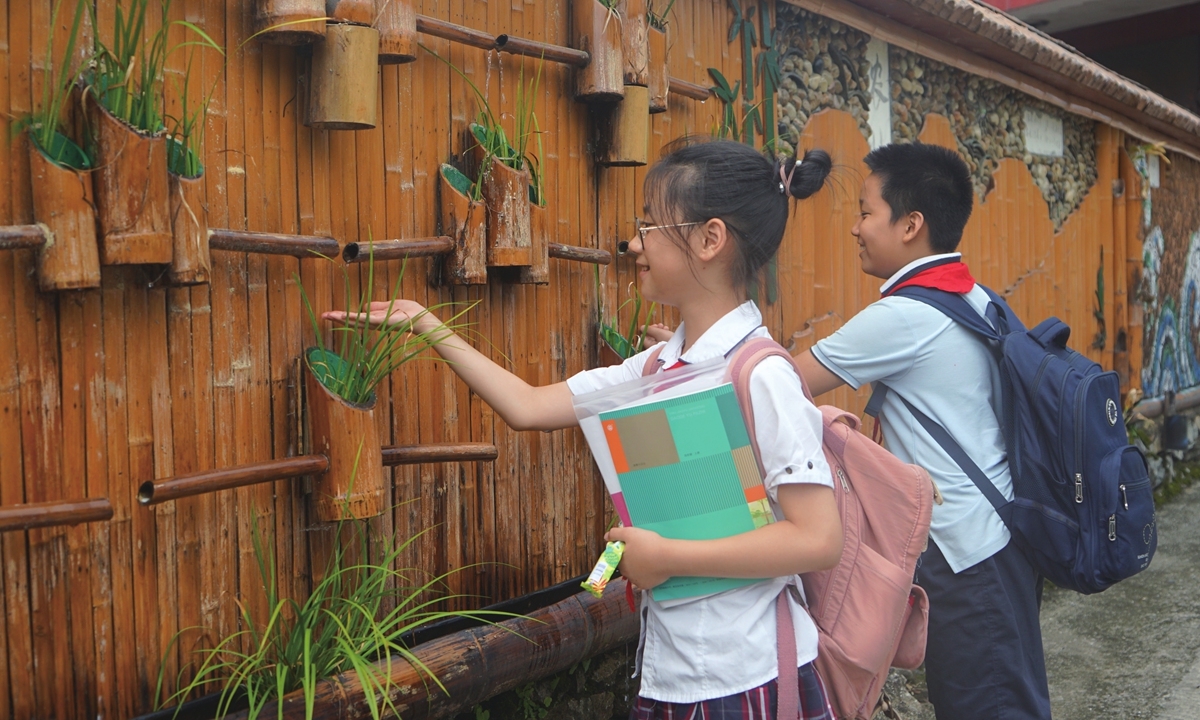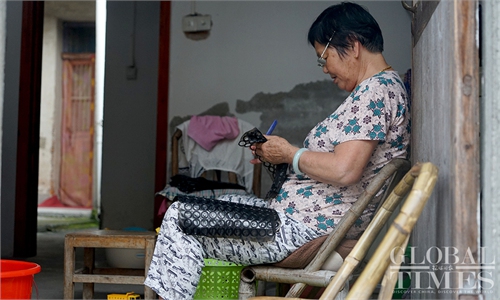Artistic talent in rural China boosts common prosperity push
Villages become a canvas for art

Two primary school students play with water in front of a wall made of bamboo and plants in Shimen village, Ninghai county, on September 7. Photo: Chen Xia/GT
It's hard to imagine rural Chinese villages' daily lives surrounded by creative art galleries, hand-made miniascape decorated with seashells, and various handcrafts made of wood.
When asked what is art in your eyes, "who knows what art was at the beginning?" giggled Ge Wanyong, Party secretary of Gejia village in Ninghai county of Ningbo, East China's Zhejiang Province. The village, with a history stretching back over 1,000 years and now home to 1,600 villagers, is about 26 kilometers away from the nearest urban center.
It was suffering from a lack of distinctive agricultural products or businesses to support the local economy. Most young people left the village in search of employment, leaving elderly residents behind to run things.
In April 2019, when Cong Zhiqiang, associate professor at the School of Art from Renmin University of China first came to this unremarkable village hidden in a mountain valley, nobody trusted him and even called him a "liar." Only just over 20 villagers came to listen to Cong's class on the first day, only six remained when the class ended.
"When villagers heard about art at the beginning, they couldn't see the connection to their daily life," Cong told the Global Times on Saturday, noting that he didn't give up despite the rough start.
In order to attract more villages to participate in the transformation, his team, together with locals, built a chair using bamboo and stones and decorated it colorfully, using all cheap materials, and built a public space for children entertainment.
Local residents quickly realized the change would improve their lives. A series of artistic installations changed villagers' mindset. "This is art? Is it so easy? I can do it too," and villagers started to give it a try by themselves.
Art transforms rural life
Changes quickly began. In the first round of transformation, the whole village spent over 50,000 yuan ($7,738) to buy materials and hire labor. In order to reduce costs, a common water tank was split in two to form the base of the installation, an abandoned door panel was repainted and attached to the design, and a unique table was thus made. The first piece sparked the creation of several more items, and most of the decorations were made from discardable materials.
What surprised villagers the most is that through cleaning up their village and creating interesting pieces of art brought them a higher income.
Yuan Xiaoxian, a 55-year-old resident of the village, discovered that she had a talent for color. Encouraged by professor Cong, Yuan was able to make cloth toys, such as 12 Chinese zodiac animals, which are now sold online priced from 30 yuan ($4.7) to over 200 yuan, after learning for about one week.
"I didn't expect that these toys could be sold," Yuan told the Global Times, noting that her handcrafts will also be sold in the county courier station, which often hosts tourists passing through the region.
Cong first taught her to decorate her house with bamboo. "I agreed because bamboo doesn't cost too much," Yuan said. However, she was astonished after seeing the decorated house. More visitors came and her homestay business became popular.
Ploughing time and energy into her new craft, Yuan's income in 2020 reached 150,000 yuan, higher than 100,000 yuan in 2019. Yuan's annual income was only 40,000 yuan in 2018.
In February 2021, the State Council released guidelines to advance the process of cultivating rural talent including handicraftsmen and traditional artists to support rural residents starting up their own business.
Incentivized by obtaining a higher income, more villagers joined in. Even some young people started to go back to the village to start their own businesses.
Ge Pin'gao, a man born after 1980, is another example. He opened a small bar in August 2019 by decorating his grandma's old house and transforming it into a real bar, which attracted visitors to enjoy drink, barbeque and chat. In 2020, the bar's revenue reached 150,000 yuan, and it is expected to reach 200,000 yuan this year.
Zhang Youli, a 29-year-old local villager, came back from the city this year. "The transformation in the village impressed me and I hope to spend more time with my family," Zhang told the Global Times, noting that she used to have a job in a beauty salon. But now she is free to sell her own handcrafts made of wood.

A woman takes photo of a tourist site in Maoyang village, Ninghai county, on September 7. The village aims to build wedding-themed attractions. Photo: Chen Xia/GT
Richer minds, and higher incomes
Polish Magdalena Gimbut and her husband Artur Piotr Rega, who are both professors from Ningbo Tech University, have visited several villages in Zhejiang as part of their research.
Unlike other villages in China, where artists and planners hired by the local governments introduced art projects to villagers but local residents often fail to embrace the value of art, Gejia village could work it out. After being educated on what art is, "Gejia villagers design and produce by themselves," Magda told the Global Times and regarded it as the most important factor behind the success.
Zhejiang is building itself into a pilot zone for common prosperity by 2025 with a focus on high-quality development. In villagers' eyes, common prosperity means not only material wealth, but also spiritual engagement.
"Mind rich, pocket rich," Magda said, noting that many villagers were seeking happiness from embracing art as most of them have retired and felt lonely. The whole village currently has 138 artists who have participated in the transformation of the community using art since 2019.
Art has changed the face of the village while also improving the lives of residents. The total economic output of Gejia village was around 120,000 yuan in 2019 but this year, "the income is expected to reach 500,000 yuan," the Party secretary Ge told the Global Times.
In Zhejiang, around 100,000 yuan of annual income for a village is at a relatively low level. The income comes from village industries such as house rental or bonus of village firms, which does not include the villagers' disposable income.
It's important to give villagers a vision of how art can help them make money as a way to "motivate them," Cong said. "Spiritual enrichment will also bring them confidence." A cleaner and more aesthetic village, along with help from professional tourism firms, will bring more tourists and boost villagers' income, Cong noted.
Zhejiang's rural residents' average disposable income was 31,930 yuan in 2020, the highest among provinces for the 36th year in a row. For Ninghai county alone, its rural residents' average disposable income reached 36,166 yuan in 2020, with the average growth rate at 8.3 percent in past five years, according to the local statistics bureau.
Gejia village residents have shared their experiences with underdeveloped village in Southwest China's Guizhou Province. "The local villagers sold their hand-made crafts worth around 50,000 yuan in less than half-a-day," Ge said. "If we become rich, we will help others to become rich together. That's common prosperity in my mind."
Spreading experience
In Cong's eyes, these small steps have set a ball in motion for an ambitious long-term vision. Following Gejia's success, it's much easier to convince other villages around. However, "homogenization should be avoided," Cong said, for instance, "you can't copy an art work. Each village should be transformed based on their own characteristic."
Nearby villages Zhangken aimed to transform itself into a Kung Fu-themed village, where visitors can experience the culture, while nearby Maoyang aims to become a wedding-themed village to attract more visitors.


